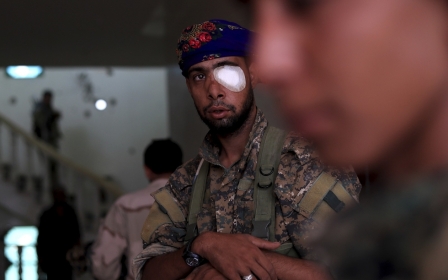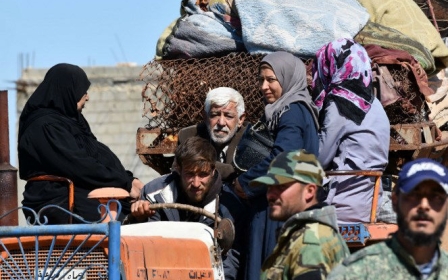Syrian government, rebels and regional powers gear up for final Idlib showdown

AMMAN - An uneasy calm hangs heavy over Syria’s rebel-held northwest. While fewer bombs have hit the country’s last major rebel stronghold in the past few days, residents and local officials are preparing for the worst amid hints of a possible pro-government offensive to retake the densely populated enclave.
The relative lull in bombing follows a major escalation in Syrian and Russian air strikes, barrel bombs and artillery fire that struck northwestern Idlib and Hama provinces throughout the week, killing at least 26 civilians and displacing tens of thousands more, according to conflict monitors and the UN.
For weeks, talk has been growing of an imminent aerial and ground offensive that would be devastating for rebel groups and civilians alike.
Some rebel commanders who spoke with Syria Direct this week still expressed hope that Turkish forces garrisoned in the north could deter a full-out assault, and that bloodshed could be limited through backdoor negotiations.
“The regime will not risk an attack” yet, predicts Abu Montasser, a leader of the Turkish-backed faction Suqour ash-Sham.
“Turkish-Russian understanding in the north is crucial [moving forward].”
But in the wake of apparent failure at last week’s Tehran summit between the leaders of Iran, Russia and Turkey - meant to negotiate a way out of a possible blitzkrieg campaign on Idlib - pro-government forces, rebel groups and regional power brokers are now digging in and preparing for whatever comes next.
The stakes are high: with nearly three million civilians, half of them internally displaced people, and some 70,000 rebel and hardline militants with nowhere left to turn, the UN has warned that Idlib risks becoming the “worst humanitarian catastrophe of the 21st century,” unless international powers return to the negotiating table.
Analysts and rebel commanders, meanwhile, tell Syria Direct that a complex web of opposing factions on the ground risks derailing any diplomatic negotiations to reduce bloodshed—“[raising] the likelihood that if this does go to a full offensive, it will be a very bloody one,” says Christopher Kozak, a senior analyst at the Institute for the Study of War in Washington DC.
“There really is no clear path forward [in Idlib],” he adds.
Assad: ‘Idlib is our goal’
Idlib, as well as rebel-held peripheries of neighboring Latakia, Aleppo and Hama provinces, remains the last major opposition pocket in Syria after a series of pro-government offensives and reconciliation agreements saw rebel territories capitulate and tens of thousands of fighters, their families and civilians sent north aboard the Syrian government’s evacuation buses.
Since pro-government forces seized all of Syria’s southwestern Daraa and Quneitra provinces in recent months through an all-out aerial and ground assault, all eyes have turned northward.
“Now, Idlib is our goal,” Syrian President Bashar al-Assad told Russian media in recent weeks, as the battle for the south came to a close.
An array of Syrian army units and allied pro-government forces have since deployed north over the past month, while Russian warships sit waiting off Syria’s Mediterranean coast. An Iranian proxy militia, Liwa Imam al-Hussein, has also reportedly deployed close to Idlib province, along with the government’s elite Tiger Forces and a handful of reconciled rebel factions.
Rebels are also reportedly hunkering down for battle. Captain Naji, spokesman for al-Jabha al-Wataniya li-Tahrir, one of two major rebel blocs active in northwestern Syria, told Syria Direct earlier this week that fighters close to pro-government frontlines had “not observed any unusual movements” pointing to a possible ground incursion, but were “preparing for all possible scenarios.”
Rows of Turkish tanks and troops meanwhile streamed into Syria’s northwest Thursday, to bolster defenses around 12 observation towers that dot the rebel-government frontlines.
Ibrahim Shimali, a media activist in southern Idlib, told Syria Direct the arrival of Turkish materiel in the area was a “major escalation from what we’ve seen before.”
With a myriad of rebel factions controlling overlapping territories across remaining rebel-held areas, two major factions have gradually emerged since 2016 to dominate Idlib’s military landscape.
Of greatest concern to all international players involved is Hay’at Tahrir a-Sham (HTS), the hardline militant faction that until last year was formally affiliated with al-Qaeda. The group and its extremist partners are estimated by various sources to include anywhere from 10,000 to 20,000 fighters, maintaining a commanding presence in some 60 percent of northwestern rebel territory.
HTS’ primary rival, the National Liberation Front (NLF), was created with significant coordination and support by Turkey in May of this year. The front is a disjointed constellation of 11 parties with wildly divergent ideologies and priorities—what they do share is some degree of reliance on and deference to the Turkish government.
“Many of these factions don’t like each other,” says Aron Lund, a fellow with US-based think tank The Century Foundation.
“I think to the extent that [Turkish-backed] armed groups are sticking together, it’s related to their dependence on Turkey.”
Ankara has moved swiftly to strengthen its military leverage and bolster the defenses of loyal factions in the NLF, with a massive shipment of munitions and GRAD rocket launchers reportedly arriving across the border in Idlib on Wednesday evening.
Turkey: Rebels’ last hope?
Central to any future offensive, and attempts to limit it, is the role played by Turkey.
Despite Turkey’s diplomatic push against an Idlib battle, these efforts yielded few tangible concessions at last week’s Tehran summit. A declaration released after the meeting pointedly excluded mention of a ceasefire or any kind of mechanism to avoid bloodshed in an upcoming campaign.
“Turkey has a hand to play here, but it’s not the strongest hand,” says Kozak.
'The alternative at this point is to fight and die in place. There is nowhere else they can be evacuated to, no clear destination for the green buses'
- Christopher Kozak, Institute for the Study of War
While Ankara’s most obvious asset may be the loyalty commanded by much of the factions party to the NLF, Turkey has also been entrenching itself in Idlib’s military landscape in more concrete terms.
Twelve Turkish observation points string the demarcation line between rebel and government control, overlooking the frontlines and the array of mirroring Russian and Iranian observation points beyond. While ostensibly built to maintain a ceasefire and de-escalation zone that has now been shattered, the points have come to resemble something akin to forward operating bases. In recent weeks, Turkish forces have been reinforcing these stations and busing in extra forces.
But Ankara’s greatest strength in an Idlib battle, Lund predicts, is its ability to expand the geography of an offensive into Turkish-occupied slices of neighboring northern Aleppo province, where tens of thousands of Free Syrian Army troops operate with Ankara’s backing.
“The fact that Idlib is next to Afrin, and that you have opposition groups there, is an important thing that people tend to overlook,” Lund tells Syria Direct, referencing one region of Turkish-occupied northern Aleppo.
“There are roads between Idlib and northern Aleppo through Afrin. You can move between these areas.”
Ankara has reportedly warned 50,000 FSA fighters in areas of Turkish control to prepare for possible deployment to Idlib, amassing some 30,000 new Turkish troops in these areas in recent weeks.
Mohammed al-Hammadi, spokesman for the Syrian National Army (SNA) in Aleppo province, confirmed to Syria Direct that plans were in place for Turkish-backed forces there to intervene in the event of an all-out offensive by pro-government forces.
“If the regime opens a [ground] campaign against Idlib, we will not stand idly by,” says al-Hammadi.
“We have numerous options and strategies in place to open more fronts in the battle of Idlib, and other [places]. We and Idlib are integrally connected.”
Other rebels cast doubts over a possible Turkish-backed intervention. A senior commander in the SNA, speaking on condition of anonymity because he was not authorized to speak to the press, played down talk of an upcoming clash.
“No one can predict what will happen if the regime actually moves towards Idlib,” the commander said.
“But I do not think Turkey will have to intervene there.”
‘The alternative is to fight and die’
Even while pro-government forces, rebels and their respective foreign backers batten out what an offensive might look like, the fate of thousands of hardline extremist fighters—hemmed between a campaign of government annihilation and a shuttered Turkish border—may be the most vexing question of all.
Turkey’s proposal for these groups appears to be for them to disband and meld into Turkish-led rebel formations.
After years of generally tolerating HTS - even cooperating to construct observation towers around the peripheries of opposition territory - Turkey officially joined the US, EU and others in designating the group a terrorist organization in late August, all the while leaving the door open for its members to join the NLF.
Abu Montasser, a commander in the rival, NLF-affiliated Suqour ash-Sham militia, sees the pressure move as a sign that Turkish diplomacy has reached its limits.
“This classification could mean that the end of HTS has been decided by Turkey, Russia and Iran,” says Abu Montasser.
“That would mean that the internal war in Idlib is coming, which is frightening for both factions and civilians.”
Kozak says that that hardline fighters—outgunned and possibly out-maneuvered as well—have simply reached the end of the line. Beyond dissolution into the NLF, the other options look grim.
“The alternative at this point is to fight and die in place,” says Kozak. “There is nowhere else they can be evacuated to, no clear destination for the green buses.”
“There really is no clear path forward, which raises the likelihood that if this does go to a full offensive, it will be a very bloody one.”
Syria Direct is a non-profit journalism organisation that focuses on coverage of Syria. Read the original article on Syria Direct. Follow Syria Direct on Twitter.
Middle East Eye propose une couverture et une analyse indépendantes et incomparables du Moyen-Orient, de l’Afrique du Nord et d’autres régions du monde. Pour en savoir plus sur la reprise de ce contenu et les frais qui s’appliquent, veuillez remplir ce formulaire [en anglais]. Pour en savoir plus sur MEE, cliquez ici [en anglais].





